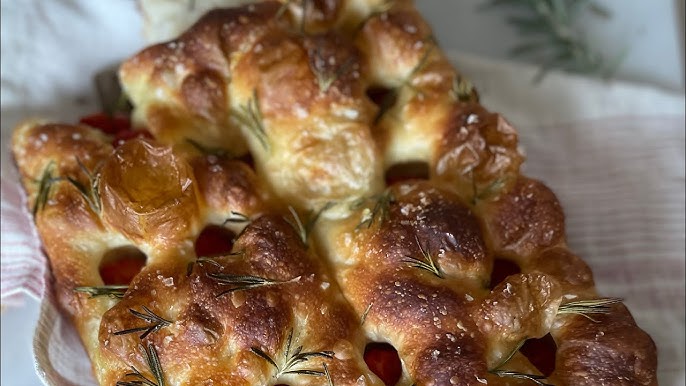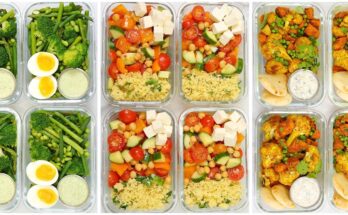Sourdough Focaccia Recipe: If you’ve ever had focaccia, you know it’s one of the most delicious and versatile breads. But have you ever tried making sourdough focaccia at home? The tangy flavor of the sourdough starter combined with the rich, olive oil-infused dough creates something truly special. Unlike other bread recipes, sourdough focaccia is soft, airy, and full of character. Whether you’re an experienced baker or a newbie, this guide will take you step by step through the process of creating this flavorful bread.
Ingredients for Sourdough Focaccia
Essential Ingredients
To get started, you’ll need the following:
- Sourdough Starter: A healthy, active starter is key for the tangy flavor and rise.
- All-Purpose Flour or Bread Flour: Provides the structure for your dough.
- Water: Use room-temperature water to mix your dough.
- Salt: Enhances the flavor and controls fermentation.
- Olive Oil: Gives focaccia its signature richness and crispy crust.
Optional Toppings and Flavors
Here’s where you can get creative! Some popular options include:
- Fresh rosemary or thyme
- Sliced cherry tomatoes
- Garlic cloves or roasted garlic
- Kalamata olives
- Sea salt flakes
Tools You’ll Need
Kitchen Tools
Before you start, gather these tools:
- Mixing bowl
- Digital scale (precision is crucial in baking)
- Baking tray or sheet pan
Handy Extras
While not essential, these can make the process smoother:
- Dough scraper for easy handling
- Proofing container with a lid
- Parchment paper to prevent sticking
Step 1: Preparing the Sourdough Starter
Your starter is the heart of this recipe, so it needs to be in top shape. Feed your starter 4–6 hours before you plan to mix the dough. It should be bubbly and doubled in size when ready to use. A healthy starter ensures a well-risen, airy focaccia.
Step 2: Mixing the Dough
In a large mixing bowl, combine the following:
- 500g flour
- 350g water
- 100g sourdough starter
- 10g salt
- 30g olive oil
Mix until all the ingredients are just combined. Don’t worry about kneading—this dough is more about patience than physical effort. Cover the bowl with a damp towel and let it rest for 30 minutes.
Step 3: Autolyse and First Rest
Autolyse is a fancy term for letting your flour and water sit together before adding salt and oil. This process helps hydrate the flour and improves dough elasticity. After mixing, let the dough rest for 30 minutes. Then, add the salt and olive oil, gently folding them into the dough until fully incorporated.
Step 4: Stretch and Fold
Over the next 2–3 hours, perform the stretch-and-fold technique every 30 minutes:
- Grab one edge of the dough, stretch it upward, and fold it over the center.
- Rotate the bowl and repeat with the other edges.
This technique develops gluten, giving the dough strength and structure without traditional kneading.
Step 5: Bulk Fermentation
After the stretch-and-fold process, cover the dough and let it ferment at room temperature for 4–6 hours. The dough should double in size and appear bubbly. If your kitchen is cool, this step may take longer. Be patient—good bread is worth the wait.
Step 6: Shaping the Dough
Once the bulk fermentation is complete, it’s time to shape the dough. Start by preparing your baking tray or sheet pan. Generously coat it with olive oil to prevent sticking and to give the focaccia its signature crispy bottom.
Gently transfer the dough onto the prepared tray. Be careful not to deflate the dough too much—those air bubbles are what make focaccia light and airy. Using your fingers, stretch the dough to fit the tray. If it resists, let it rest for 10–15 minutes and try again. Don’t rush this step; patience is key for an even, airy crumb.
Step 7: Final Proof
Once the dough is shaped, cover the tray with a damp kitchen towel or plastic wrap. Let the dough proof for 2–4 hours, depending on the temperature of your kitchen. You’ll know it’s ready when the dough has visibly puffed up and springs back slightly when you press it with your finger.
Step 8: Adding Toppings
This is the fun part—decorating your focaccia! Drizzle a generous amount of olive oil over the surface. Then, use your fingers to create dimples across the dough. The dimples not only give focaccia its iconic look but also help hold toppings and prevent the dough from over-rising in the oven.
Sprinkle sea salt flakes evenly over the dough, then add your desired toppings. For example:
- Herb Focaccia: Sprinkle fresh rosemary or thyme for a classic flavor.
- Tomato and Basil Focaccia: Add halved cherry tomatoes and fresh basil leaves.
- Garlic and Olive Focaccia: Scatter sliced garlic and pitted olives for a savory twist.
Step 9: Baking Your Focaccia
Preheat your oven to 220°C (430°F). A hot oven is essential for achieving a golden, crispy crust. Place the tray on the middle rack and bake for 20–25 minutes, or until the focaccia is deeply golden and aromatic.
For an extra-crispy bottom, you can place the tray on a preheated pizza stone or steel during baking. Check for doneness by lifting the focaccia slightly—if the bottom is golden brown, it’s ready.
Step 10: Cooling and Serving
Once the focaccia is out of the oven, resist the urge to cut into it immediately. Allow it to cool on a wire rack for at least 15–20 minutes. This lets the crumb set and ensures the bread slices cleanly.
When ready to serve, cut the focaccia into squares or strips. It pairs perfectly with soups, salads, or even as a base for sandwiches. You can also serve it alongside olive oil and balsamic vinegar for dipping.
Tips for Perfect Sourdough Focaccia Every Time
- Use a Digital Scale: Precision matters in baking. Weighing your ingredients ensures consistency.
- Don’t Rush Proofing: Proper fermentation is what gives sourdough its characteristic flavor and texture.
- Keep It Hydrated: Focaccia dough is high in hydration, so don’t skimp on the water or olive oil.
- Experiment with Toppings: Make it your own by adding seasonal ingredients or unique flavor combinations.
Troubleshooting Your Sourdough Focaccia
- Overproofed Dough: If your dough collapses or doesn’t hold its shape, it may have overproofed. Reduce proofing time next time.
- Dense Texture: This could mean your starter wasn’t active enough, or the dough didn’t ferment long enough.
- Sticky Dough: High-hydration dough is naturally sticky, but if it’s unmanageable, lightly oil your hands when handling it.
Storing and Reheating Focaccia
To store focaccia, wrap it tightly in plastic wrap or place it in an airtight container. It will stay fresh at room temperature for up to two days. For longer storage, freeze it in a sealed bag for up to three months.
To reheat, preheat your oven to 180°C (350°F). Wrap the focaccia in foil and warm it for 10–15 minutes. For a crispier texture, uncover the foil for the last 5 minutes.
FAQs about Sourdough Focaccia Recipe
1. What is sourdough focaccia?
Sourdough focaccia is a variant of the traditional Italian bread made using sourdough starter instead of commercial yeast. This gives the bread a distinctive tangy flavor and a chewy texture, which pairs beautifully with the olive oil and herb toppings typical of focaccia.
2. How long does it take to make sourdough focaccia?
The total time required can vary, but generally, it includes about 12 to 14 hours of fermentation and proofing, with about 20 to 25 minutes of baking. Preparation time is minimal, though, typically under 30 minutes.
3. Can I make sourdough focaccia without a sourdough starter?
No, a sourdough starter is essential for making sourdough focaccia as it acts as the leavening agent. However, you can create your own starter at home with flour and water over several days.
4. What are some common toppings for sourdough focaccia?
Popular toppings include rosemary, sea salt, cherry tomatoes, olives, and caramelized onions. You can customize the toppings based on your taste preferences.
5. How do I store leftover sourdough focaccia?
Leftover sourdough focaccia can be stored in an airtight container at room temperature for up to 2 days. For longer storage, wrap it well and freeze for up to a month. Reheat in the oven for best results.
6. Is sourdough focaccia healthy?
Sourdough focaccia can be a healthier option compared to other breads as the sourdough fermentation process helps to reduce phytates, which makes it easier to digest and may improve nutrient absorption.
7. Can I use whole wheat flour to make sourdough focaccia?
Yes, whole wheat flour can be used either in part or fully to increase the nutritional content. Keep in mind that whole wheat flour will result in a denser and nuttier bread.
Conclusion
Making sourdough focaccia at home is a rewarding experience that combines art and science. With its soft, airy crumb and crispy edges, this bread is perfect for any occasion. Follow this step-by-step guide, and you’ll have a delicious loaf that’s bound to impress your friends and family. Experiment with toppings, play with flavors, and make it your own—you’re now a sourdough focaccia pro!



